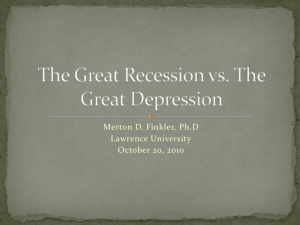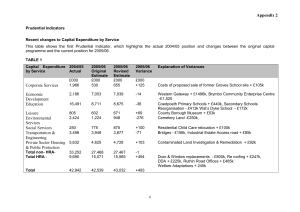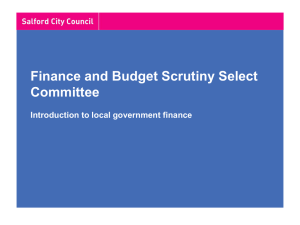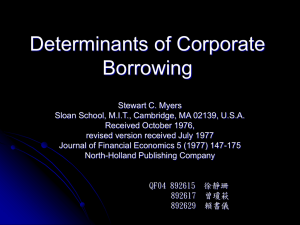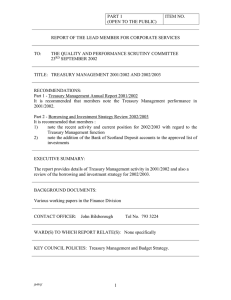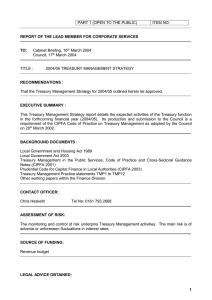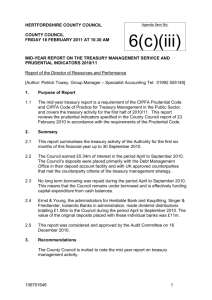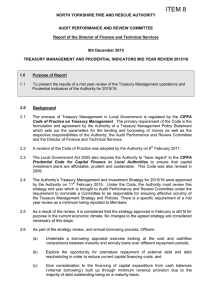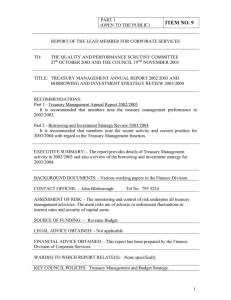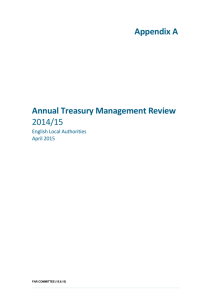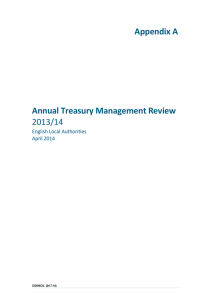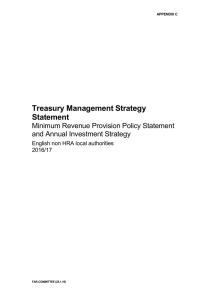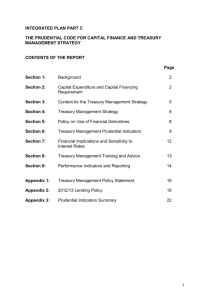View as DOC (2) 250 KB
advertisement
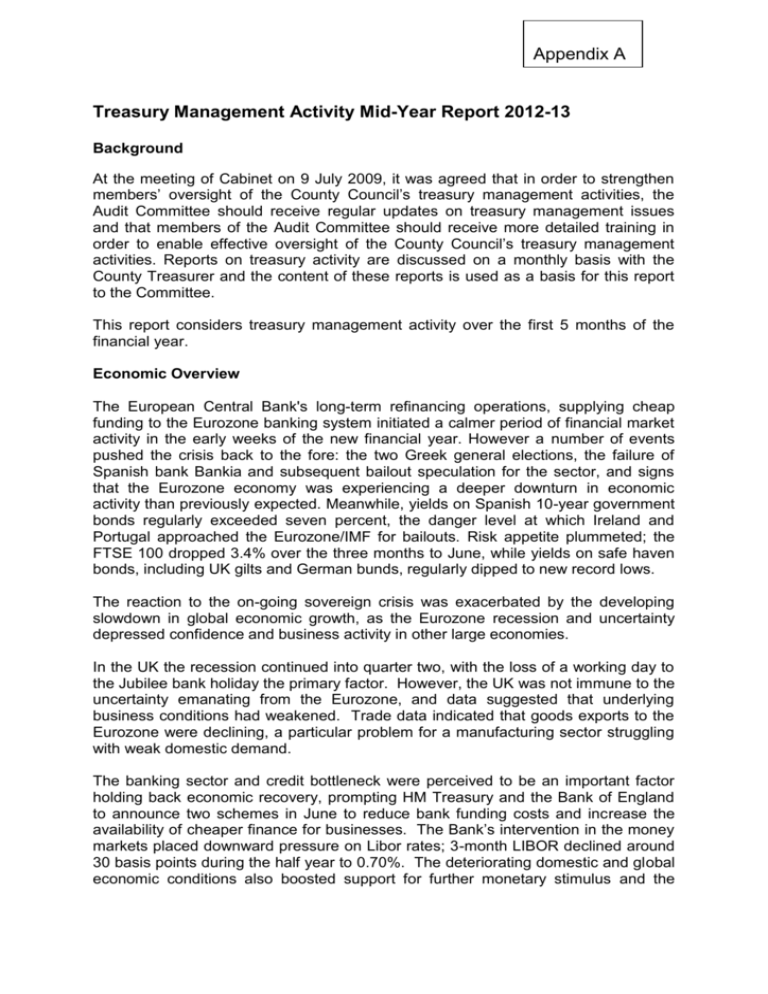
Appendix A Treasury Management Activity Mid-Year Report 2012-13 Background At the meeting of Cabinet on 9 July 2009, it was agreed that in order to strengthen members’ oversight of the County Council’s treasury management activities, the Audit Committee should receive regular updates on treasury management issues and that members of the Audit Committee should receive more detailed training in order to enable effective oversight of the County Council’s treasury management activities. Reports on treasury activity are discussed on a monthly basis with the County Treasurer and the content of these reports is used as a basis for this report to the Committee. This report considers treasury management activity over the first 5 months of the financial year. Economic Overview The European Central Bank's long-term refinancing operations, supplying cheap funding to the Eurozone banking system initiated a calmer period of financial market activity in the early weeks of the new financial year. However a number of events pushed the crisis back to the fore: the two Greek general elections, the failure of Spanish bank Bankia and subsequent bailout speculation for the sector, and signs that the Eurozone economy was experiencing a deeper downturn in economic activity than previously expected. Meanwhile, yields on Spanish 10-year government bonds regularly exceeded seven percent, the danger level at which Ireland and Portugal approached the Eurozone/IMF for bailouts. Risk appetite plummeted; the FTSE 100 dropped 3.4% over the three months to June, while yields on safe haven bonds, including UK gilts and German bunds, regularly dipped to new record lows. The reaction to the on-going sovereign crisis was exacerbated by the developing slowdown in global economic growth, as the Eurozone recession and uncertainty depressed confidence and business activity in other large economies. In the UK the recession continued into quarter two, with the loss of a working day to the Jubilee bank holiday the primary factor. However, the UK was not immune to the uncertainty emanating from the Eurozone, and data suggested that underlying business conditions had weakened. Trade data indicated that goods exports to the Eurozone were declining, a particular problem for a manufacturing sector struggling with weak domestic demand. The banking sector and credit bottleneck were perceived to be an important factor holding back economic recovery, prompting HM Treasury and the Bank of England to announce two schemes in June to reduce bank funding costs and increase the availability of cheaper finance for businesses. The Bank’s intervention in the money markets placed downward pressure on Libor rates; 3-month LIBOR declined around 30 basis points during the half year to 0.70%. The deteriorating domestic and global economic conditions also boosted support for further monetary stimulus and the Monetary Policy Committee (MPC) duly increased the Asset Purchase Facility by £50bn to £375bn, the third tranche of quantitative easing. Interest Rate Environment Short term interest rates continue at the very low levels since the Bank of England reduced base rate to 0.5% in March 2009. The chart below shows the downward pressure and movement of rates over the first half of the year. Current longer term Public Works Loan Board (PWLB) rates are shown below. During the summer uncertainty in world markets has increased the demand for UK government debt which has benefited UK interest rates. The effects of this can be seen in the fall of the PWLB rates in the period. The shape of the curve has remained constant with rates much lower at the short end. Outlook for Interest Rates The recent downward trend in the CPI inflation rate allied with the apparent synchronised global downturn led by the Eurozone has pushed market expectations for a rise in interest rate out to at least 2014. Although previously discounted by the MPC, there is now also the possibility of a cut in Bank Rate to 0.25%. The latest central forecast from the Council’s treasury management advisers, Sterling Consultancy Services is shown below. The risks to the forecast remain heavily to the downside, arising largely from the impact of the Eurozone sovereign debt crisis on UK business and household confidence. Period Q3 2012 Q4 2012 Q1 2013 Q2 2013 Q3 2013 Q4 2013 H1 2014 H2 2014 H1 2015 H2 2015 Bank Rate 0.50 0.50 0.50 0.50 0.50 0.75 1.25 1.75 2.25 2.75 3 month 12 month LIBOR LIBOR 0.70 1.40 0.65 1.20 0.65 1.30 0.70 1.40 0.70 1.45 0.95 1.60 1.45 2.00 1.95 2.50 2.45 3.00 2.90 3.50 25-year PWLB rate 4.00 4.10 4.10 4.15 4.25 4.50 4.85 5.10 5.25 5.50 Current Treasury Management Policy The current borrowing policy of keeping a higher proportion of borrowing at variable rates or short dated maturities is enabling the County Council to take advantage of the very low rates available on short term borrowing. In addition, given that the current pressure on rates is still downwards, it positions the County Council to take advantage of any further falls in longer term rates in the near future. The current investment policy of accessing high credit quality institutions through bond investments as opposed to placing fixed term deposits directly with banks continues to be the County Council's preferred strategy given the continued difficult credit environment. Investment Activity The table below shows investment activity during April to August 2012 Bank Deposits Balance 1st April Maturities New Investments Balance 31st August Call Fixed Structured Total £m £m £m 22.90 (1069.79) 1063.40 140.60 (11.00) - 124.18 - 287.68 (1080.79) 1063.40 16.51 129.60 124.18 270.29 £m Bonds Local Authority Bonds UK Govt Gilts Corporate & Supranationals Total Balance 1st April Maturities New Investments £m 20.66 17.25 £m 265.02 (935.84) 849.74 £m 0.07 (209.45) 295.80 £m 285.75 (1145.29) 1162.79 Balance 31st August 37.91 178.92 86.42 303.25 Overall the level of investments has remained static, however the continued heightened credit risk profile of European interest rate markets and the ongoing liquidity issues for the banks and their funding position required a re-alignment of credit exposure, and maturing fixed deposits have not been replaced, but rather switched into the relative security of government and highly rated corporate bonds. Additionally the County Council is examining whether it is possible to negotiate the provision of collateral by counterparties for some traditional deposits as a means of further reducing risk exposure. Borrowing Activity Current market conditions continue to enable the County Council to take advantage of short term market borrowing. The table below shows the borrowing activity which has taken place between April and the end of August 2012. The total is net of transferred debt. PWLB Fixed Rate £m Balance 1st April Maturities New Borrowing Balance 31st August 167.87 Long PWLB Term Variable Market Rate Loan £m £m 185.75 51.66 63.19 773.07 ( 201.60) (333.59) (595.19) 0.35 176.50 365.47 542.75 52.01 279.50 95.07 720.63 0.43 125.75 TOTAL £m 304.60 (60.00) 168.30 Other Locals £m Police, Fire and Lancashire District Councils £m As part of the strategy to reduce credit risk, the County Council has been following a policy of reducing borrowing levels and this has continued over the first half of the current financial year. Total borrowing now stands at £1.139m including the financing of £419m of assets through Private Finance Initiative schemes. Prudential Indicators The Local Government Act 2003 and supporting regulations require the County Council to have regard to the prudential code and to set prudential indicators to ensure the County Council's capital investment plans are affordable, prudent and sustainable. A comparison of the actual position at 31st August 2012 compared to the prudential indicators set in the treasury management strategy for 2012/13 is set out below. Treasury Management Prudential Indicators 2012/13 £M 1. Adoption of CIPFA TM Code of Practice 31stAug Actual £M ADOPTED 2. Authorised limit for external debt - A prudent estimate of debt, which reflects the Authority’s capital expenditure plans and allows sufficient headroom for unusual cash movements. Borrowing 791 720 Other long-term liabilities(PFI schemes) 525 419 1316 1139 TOTAL 3. Operational boundary for external debt - A prudent estimate of debt, but no provision for unusual cash movements. It represents the estimated maximum external debt arising as a consequence of the County Council's current plans. Borrowing 741 720 Other long-term liabilities 475 419 TOTAL 1216 1139 4. Maturity structure of debt Lower Limit % Upper Limit % Actual % Under 12 months 75 51.98 12 months and within 2 years 75 - 2 years and within 5 years 75 - 5 years and within 10 years 75 21.40 100 26.61 10 years and above 25 The graph below shows the level of debt for each day of the past calendar year compared with the prudential indicator operational and authorised boundaries. Budget Monitoring Position At this stage in the year the forecast, as recently reported to the Cabinet, remains that the financing charges budget set out in the table below will be on budget at the end of the financial year. Cash Limit £m MRP Interest Paid Interest Received Grants Est Actual £m 25.996 20.720 (11.309) (0.403) 25.996 20.720 (11.039) (0.403) 35.004 35.004 Variance £m - This position is kept under regular review taking account both of ongoing performance and also market movements and the forecast is provided to the County Treasurer on a monthly basis.



